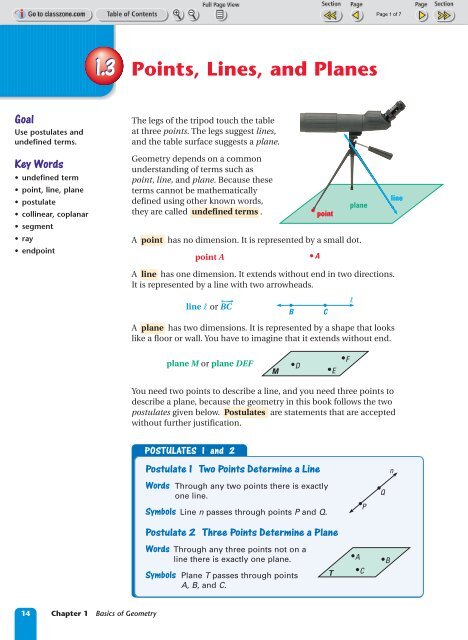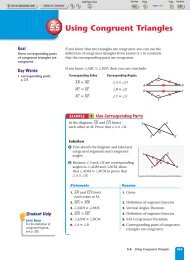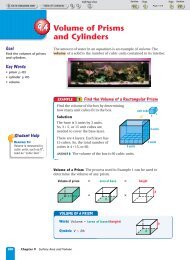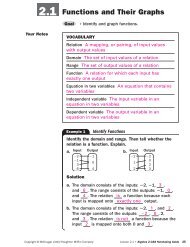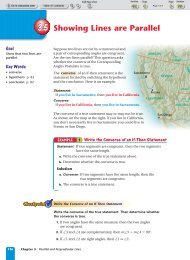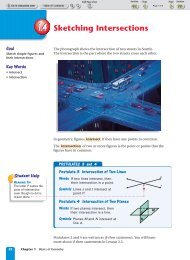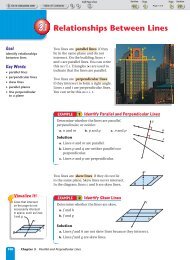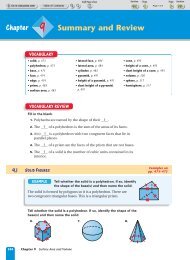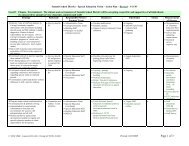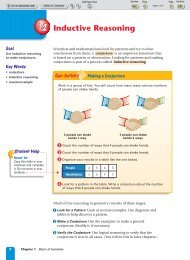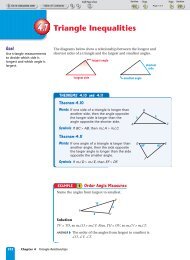Create successful ePaper yourself
Turn your PDF publications into a flip-book with our unique Google optimized e-Paper software.
Goal<br />
Use postulates <strong>and</strong><br />
undefined terms.<br />
Key Words<br />
• undefined term<br />
• point, line, plane<br />
• postulate<br />
• collinear, coplanar<br />
• segment<br />
• ray<br />
• endpoint<br />
14 Chapter 1 Basics of Geometry<br />
<strong>1.3</strong> <strong>Points</strong>, <strong>Lines</strong>, <strong>and</strong> <strong>Planes</strong><br />
The legs of the tripod touch the table<br />
at three points. The legs suggest lines,<br />
<strong>and</strong> the table surface suggests a plane.<br />
Geometry depends on a common<br />
underst<strong>and</strong>ing of terms such as<br />
point, line, <strong>and</strong> plane. Because these<br />
terms cannot be mathematically<br />
defined using other known words,<br />
they are called undefined terms .<br />
A point has no dimension. It is represented by a small dot.<br />
point A<br />
A line has one dimension. It extends without end in two directions.<br />
It is represented by a line with two arrowheads.<br />
line l or BC ^&*(<br />
A plane has two dimensions. It is represented by a shape that looks<br />
like a floor or wall. You have to imagine that it extends without end.<br />
plane M or plane DEF<br />
You need two points to describe a line, <strong>and</strong> you need three points to<br />
describe a plane, because the geometry in this book follows the two<br />
postulates given below. Postulates are statements that are accepted<br />
without further justification.<br />
POSTULATES 1 <strong>and</strong> 2<br />
Postulate 1 Two <strong>Points</strong> Determine a Line<br />
Words Through any two points there is exactly<br />
one line.<br />
Symbols Line n passes through points P <strong>and</strong> Q.<br />
Postulate 2 Three <strong>Points</strong> Determine a Plane<br />
Words Through any three points not on a<br />
line there is exactly one plane.<br />
Symbols Plane T passes through points<br />
A, B, <strong>and</strong> C.<br />
M<br />
B<br />
D<br />
A<br />
C<br />
T<br />
E<br />
F<br />
plane<br />
l<br />
A<br />
P<br />
C<br />
P<br />
B<br />
n
Visualize It!<br />
D<br />
H<br />
E F<br />
In Example 2 the points<br />
D, E, F, <strong>and</strong> H are also<br />
coplanar. The plane<br />
containing them is<br />
shown in green above.<br />
EXAMPLE 1 Name <strong>Points</strong>, <strong>Lines</strong>, <strong>and</strong> <strong>Planes</strong><br />
Use the diagram at the right.<br />
a. Name three points.<br />
b. Name two lines.<br />
c. Name two planes.<br />
Solution<br />
a. D, E, <strong>and</strong> F are points.<br />
b. Line m <strong>and</strong> line p<br />
c. Q <strong>and</strong> R are planes.<br />
Collinear points<br />
Coplanar points<br />
Coplanar lines<br />
Name <strong>Points</strong>, <strong>Lines</strong>, <strong>and</strong> <strong>Planes</strong><br />
Use the diagram at the right.<br />
1. Name two lines.<br />
2. Name two planes.<br />
are points that lie on the same line.<br />
are points that lie on the same plane.<br />
are lines that lie on the same plane.<br />
EXAMPLE 2 Name Collinear <strong>and</strong> Coplanar <strong>Points</strong><br />
Use the diagram at the right.<br />
a. Name three points that are collinear.<br />
b. Name four points that are coplanar.<br />
c. Name three points that are not collinear.<br />
Solution<br />
a. <strong>Points</strong> D, E, <strong>and</strong> F lie on the same line. So, they are collinear.<br />
b. <strong>Points</strong> D, E, F, <strong>and</strong> G lie on the same plane, so they are coplanar.<br />
c. <strong>Points</strong> H, E, <strong>and</strong> G do not lie on the same line. There are many<br />
other correct answers.<br />
3. Name three points that are collinear.<br />
4. Name three points that are not collinear.<br />
5. Name four points that are coplanar.<br />
6. Name two lines that are coplanar.<br />
Œ<br />
D<br />
T<br />
E<br />
p<br />
F<br />
A<br />
D<br />
n<br />
m<br />
C<br />
B<br />
E<br />
D<br />
S<br />
<strong>1.3</strong> <strong>Points</strong>, <strong>Lines</strong>, <strong>and</strong> <strong>Planes</strong> 15<br />
p<br />
R<br />
E<br />
G<br />
H<br />
F<br />
m
Student Help<br />
VISUAL STRATEGY<br />
Add these words to<br />
your vocabulary pages<br />
in your notebook, as<br />
shown on p. 2.<br />
16 Chapter 1 Basics of Geometry<br />
The line AB ^&( passes through A <strong>and</strong> B.<br />
The segment AB &* consists of the endpoints A <strong>and</strong> B, <strong>and</strong> all points<br />
on AB ^&( that are between A <strong>and</strong> B.<br />
The ray AB&( consists of the endpoint A <strong>and</strong> all points on AB ^&( that lie<br />
on the same side of A as B.<br />
SUMMARY<br />
Draw <strong>Lines</strong>, Segments, <strong>and</strong> Rays<br />
LINES, SEGMENTS, <strong>and</strong> RAYS<br />
Word Symbol Diagram<br />
line AB ^&( or BA ^&(<br />
segment AB&* or BA&*<br />
ray AB&(<br />
BA&(<br />
A<br />
endpoint endpoint<br />
A B<br />
endpoint<br />
A<br />
Note that AB ^&( is the same as BA ^&(. Also, AB&* is the same as BA&*.<br />
However, AB&( is not the same as BA &(. The two rays have different<br />
endpoints <strong>and</strong> extend in different directions.<br />
EXAMPLE 3 Draw <strong>Lines</strong>, Segments, <strong>and</strong> Rays<br />
A<br />
B<br />
B<br />
endpoint<br />
B<br />
Draw three noncollinear points, J, K, <strong>and</strong> L. Then draw ^&(, JK KL &*, <strong>and</strong> LJ **(.<br />
Solution<br />
●1 Draw J, K, <strong>and</strong> L. ●2 Draw ^&(. JK ●3 Draw KL&* . ●4 Draw LJ&(.<br />
J<br />
K<br />
7. Draw four points as shown.<br />
L<br />
8. Draw the lines AB ^&( <strong>and</strong> AC ^&(. Are the<br />
lines the same? Explain.<br />
9. Draw the line segments AC&* <strong>and</strong> BD &*.<br />
Are the segments the same? Explain.<br />
J<br />
10. Draw the rays CA &( <strong>and</strong> CB&(. Are the rays the same? Explain.<br />
K<br />
L<br />
J<br />
K<br />
L<br />
A B C<br />
D<br />
J<br />
K<br />
L
<strong>1.3</strong><br />
Exercises<br />
Guided Practice<br />
Vocabulary Check<br />
1. Write in words how you would say each of these symbols aloud:<br />
PQ ^&(, PQ&*, PQ&(, <strong>and</strong> QP &(.<br />
2. Explain the difference between PQ&( <strong>and</strong> QP &(.<br />
Decide whether the statement is true or false.<br />
3. <strong>Points</strong> A, B, <strong>and</strong> C are collinear.<br />
4. <strong>Points</strong> A, B, <strong>and</strong> C are coplanar.<br />
5. <strong>Points</strong> B, C, <strong>and</strong> D are coplanar.<br />
6. Point C lies on AB ^&(.<br />
7. AB ^&( lies on plane ABC.<br />
8. DE ^&( lies on plane ABC.<br />
Practice <strong>and</strong> Applications<br />
Extra Practice<br />
See p. 675.<br />
Skill Check<br />
Homework Help<br />
Example 1: Exs. 15–18<br />
Example 2: Exs. 19–62<br />
Example 3: Exs. 63–65<br />
Sketch a line that contains point S between points R <strong>and</strong> T. Decide<br />
whether the statement is true or false.<br />
9. RS ^&( is the same as RT ^&(. 10. ST&( is the same as TS &(.<br />
11. ST&( is the same as RT &(. 12. RS &( is the same as RT&(.<br />
13. RS &* is the same as ST&*. 14. ST&* is the same as TS &*.<br />
Naming <strong>Points</strong>, <strong>Lines</strong>, <strong>and</strong> <strong>Planes</strong> Use the diagram at the right.<br />
15. Name four points.<br />
16. Name two lines.<br />
17. Name the plane that contains A, B, <strong>and</strong> C.<br />
18. Name the plane that contains A, D, <strong>and</strong> E.<br />
Evaluating Statements Decide whether the statement is<br />
true or false.<br />
19. A lies on line l. 20. A, B, <strong>and</strong> C are collinear.<br />
21. B lies on line l. 22. A, B, <strong>and</strong> C are coplanar.<br />
23. C lies on line m. 24. D, E, <strong>and</strong> B are collinear.<br />
25. D lies on line m. 26. D, E, <strong>and</strong> B are coplanar.<br />
A<br />
T<br />
B<br />
D<br />
E<br />
A B<br />
<strong>1.3</strong> <strong>Points</strong>, <strong>Lines</strong>, <strong>and</strong> <strong>Planes</strong> 17<br />
A<br />
D<br />
C<br />
E<br />
D<br />
E<br />
C<br />
C m<br />
S<br />
B<br />
l
IStudent Help<br />
I CLASSZONE.COM<br />
HOMEWORK HELP<br />
Extra help with problem<br />
solving in Exs. 38–53 is<br />
at classzone.com<br />
18 Chapter 1 Basics of Geometry<br />
Naming Collinear <strong>Points</strong> Name a point that<br />
is collinear with the given points.<br />
27. F <strong>and</strong> H 28. G <strong>and</strong> K<br />
29. K <strong>and</strong> L 30. M <strong>and</strong> J<br />
31. J <strong>and</strong> N 32. K <strong>and</strong> H<br />
33. H <strong>and</strong> G 34. J <strong>and</strong> F<br />
Naming Noncollinear <strong>Points</strong> Name three points that are not<br />
collinear.<br />
35. 36. 37.<br />
U<br />
W X<br />
V<br />
R<br />
N P P<br />
Naming Coplanar <strong>Points</strong> Name a point that is coplanar with the<br />
given points.<br />
38. A, B, <strong>and</strong> C 39. D, C, <strong>and</strong> F<br />
40. G, A, <strong>and</strong> D 41. E, F, <strong>and</strong> G<br />
42. A, B, <strong>and</strong> H 43. B, C, <strong>and</strong> F<br />
44. A, B, <strong>and</strong> F 45. B, C, <strong>and</strong> G<br />
Naming Noncoplanar <strong>Points</strong> Name all the points that are not<br />
coplanar with the given points.<br />
46. N, K, <strong>and</strong> L 47. S, P, <strong>and</strong> M<br />
48. P, Q, <strong>and</strong> N 49. R, S, <strong>and</strong> L<br />
50. P, Q, <strong>and</strong> R 51. R, K, <strong>and</strong> N<br />
52. P, S, <strong>and</strong> K 53. Q, K, <strong>and</strong> L<br />
Game Board In Exercises 54–57, use the game board.<br />
54. Name four collinear points.<br />
55. Name three points that are not<br />
collinear.<br />
56. Name four segments that<br />
contain point R.<br />
R S<br />
57. AD ^&( divides the board in half.<br />
QT ^&( also divides the board in half.<br />
Name the other lines that divide<br />
the board in half.<br />
T<br />
A<br />
H<br />
N<br />
P<br />
A<br />
P<br />
G<br />
K<br />
F<br />
H<br />
J<br />
L N<br />
M<br />
A<br />
Z Y<br />
B C<br />
D<br />
E<br />
F<br />
G<br />
K L<br />
M<br />
R<br />
P<br />
F V<br />
C<br />
U<br />
T<br />
P<br />
S<br />
B<br />
R<br />
S<br />
E D
You be the Judge<br />
indoor tennis court.<br />
58. Name two points that are<br />
collinear with P.<br />
59. Name three points that are<br />
coplanar with P.<br />
60. Name two planes that contain J.<br />
61. Name two planes that do not<br />
contain J.<br />
62. Are the points K <strong>and</strong> N coplanar<br />
with points J <strong>and</strong> Q? Explain.<br />
In Exercises 58–62, use the diagram of the<br />
Sketch the lines, segments, <strong>and</strong> rays. If you have<br />
geometry software, try creating your sketch using it.<br />
63. Draw four points J, K, L, <strong>and</strong> M, no three of<br />
which are collinear. Sketch ^**(, JK KL &*, LM ^&(, <strong>and</strong> MJ &(.<br />
64. Draw two points, A <strong>and</strong> B. Sketch AB&(. Add a<br />
point C on the ray so B is between A <strong>and</strong> C.<br />
65. Draw three noncollinear points F, G, <strong>and</strong> H.<br />
Sketch FG&* <strong>and</strong> add a point J on FG&*.<br />
Then sketch JH&(.<br />
Three-Wheeled Car In Exercises 66–69, refer to the photograph of<br />
the three-wheeled car.<br />
66. A four-wheeled car is driving slowly over uneven ground. Is it<br />
possible that only three wheels will be touching the ground at a<br />
given time?<br />
67. Is it possible to draw four points that do not lie on a plane?<br />
68. A three-wheeled car is driving slowly over uneven ground. Is it<br />
possible that only two wheels will be touching the ground at a<br />
given time?<br />
69. Is it possible to draw three points that do not lie on a plane?<br />
<strong>1.3</strong> <strong>Points</strong>, <strong>Lines</strong>, <strong>and</strong> <strong>Planes</strong> 19<br />
J<br />
L<br />
K<br />
M
St<strong>and</strong>ardized Test<br />
Practice<br />
Quiz 1<br />
Mixed Review<br />
Algebra Skills<br />
20 Chapter 1 Basics of Geometry<br />
70. Multiple Choice Which of the statements is false?<br />
A F, G, <strong>and</strong> H are collinear.<br />
B C, D, K, <strong>and</strong> L are coplanar.<br />
C L lies on AB ^&(.<br />
D DE &*( contains CE &*.<br />
Describing Number Patterns Predict the next number.<br />
(Lesson 1.1)<br />
71. 6, 17, 28, 39, . . . 72. 9, 4, 1, 6, . . .<br />
73. 4, 20, 100, 500, . . . 74. 0, 5, 15, 30, 50, . . .<br />
Fractions Write the fraction as a decimal. For repeating decimals,<br />
round to the nearest hundredth. (Skills Review, p. 657)<br />
75. 1<br />
76. 3 77. 3<br />
2 4 5 78. 4<br />
<br />
10<br />
79. 2<br />
1<br />
80. 4 81. 7 82. 1 <br />
3 3 9 2<br />
Sketch the next figure you expect in the pattern. (Lesson 1.1)<br />
1. 2.<br />
Find a counterexample to prove that the statement is false.<br />
(Lesson 1.2)<br />
3. If a number is divisible by 10, then it is divisible by 20.<br />
4. Two sides of a triangle can never have the same length.<br />
5. The sum of two numbers is always greater than either number.<br />
6. If you fold a square piece of paper in half, then unfold it <strong>and</strong><br />
cut along the fold, you will always create two rectangles of the<br />
same size.<br />
Sketch the figure. (Lesson <strong>1.3</strong>)<br />
H<br />
G<br />
F<br />
A K<br />
L<br />
B C<br />
D E<br />
7. Draw three noncollinear points P, Q, <strong>and</strong> R. Sketch QP &*(. Add<br />
a point T on the ray so that P is between Q <strong>and</strong> T. Then sketch RT ^&(.<br />
8. Draw four points, V, X, Y, <strong>and</strong> Z, no three of which are collinear.<br />
Sketch VY ^&(, XZ ^&(, <strong>and</strong> YZ ^&(.


